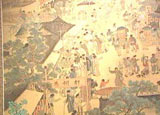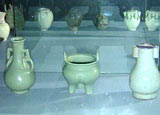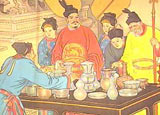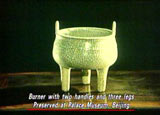 |
|
Imperial Kiln of Southern Song Dynasty |
| CCTV.COM 2003-11-03 14:11:55 |
|
 Production of Chinese porcelain flourished during the Song Dynasty. The five major kilns were Guan Kiln, Ge Kiln, Ru Kiln, Ding Kiln and Jun Kiln. Guan Kiln, or the Imperial Kiln, was the leading one. It baked porcelain exclusively for the imperial court. There were the Imperial Kiln of the Northern Song and the Imperial Kiln of the Southern Song. Production of Chinese porcelain flourished during the Song Dynasty. The five major kilns were Guan Kiln, Ge Kiln, Ru Kiln, Ding Kiln and Jun Kiln. Guan Kiln, or the Imperial Kiln, was the leading one. It baked porcelain exclusively for the imperial court. There were the Imperial Kiln of the Northern Song and the Imperial Kiln of the Southern Song.
The Imperial Kiln of the Southern Song Dynasty was modeled on that of the Northern Song Dynasty after the imperial family moved its capital southward to Hangzhou. It was built to bake porcelain for daily use in the imperial court and for sacrificial rites.
 Porcelain is a combination of craftsmanship and art. It should be an object of practical use and a work of art. A large quantity of exquisite porcelain has been unearthed from the Tiger Cave kiln site In Hangzhou City. It includes high-quality porcelain for daily use and imitations of bronze for sacrificial rites. The porcelain was glazed for both practical use and decorative purposes. In particular, some porcelain was baked as ornaments in the imperial court. To meet aesthetic requirements, much attention was paid to the beauty of glaze when porcelain was baked in the Imperial Kiln of the Southern Song Dynasty. Porcelain is a combination of craftsmanship and art. It should be an object of practical use and a work of art. A large quantity of exquisite porcelain has been unearthed from the Tiger Cave kiln site In Hangzhou City. It includes high-quality porcelain for daily use and imitations of bronze for sacrificial rites. The porcelain was glazed for both practical use and decorative purposes. In particular, some porcelain was baked as ornaments in the imperial court. To meet aesthetic requirements, much attention was paid to the beauty of glaze when porcelain was baked in the Imperial Kiln of the Southern Song Dynasty.
“The major feature was the feeling of heavy and smooth jade when glaze was applied. So the glaze needed to be thickened. The porcelain body was thinned when the glaze was thick. The thick glaze and thin body were major characteristics of porcelain baked at the Imperial Kiln of Southern Song,” said Li Huibing, research fellow of Palace Museum of Beijing.
 Crackles in the glaze were flaws that appeared on the surface of porcelain in the process of baking. As a unique artistic style, they were deliberately made as decorative patterns on porcelain. Crackles in the glaze were flaws that appeared on the surface of porcelain in the process of baking. As a unique artistic style, they were deliberately made as decorative patterns on porcelain.
“Crackles were divided into several types, including broken-ice crackles. The glaze was very thick and the body between two layers of glaze was very thin. So the glaze could show the effects of beautiful broken-ice crackles. Besides broken-ice crackles, one type was known as “gold silk and iron thread.” The thick black crackles were “iron thread.” The thin yellow crackles were “gold silk.” In fact, they were like two nets covering the porcelain vase. This was an important feature of porcelain from the Imperial Kiln of Southern Song. It was also a symbol of overwhelming beauty.” said Li Huibing, research fellow of Palace Museum of Beijing.
 The porcelain baked at the Imperial Kiln of the Southern Song Dynasty was elegant and of primitive simplicity. It showed the changes in the aesthetic standards of people during the Song Dynasty. The superb Chinese porcelain has become treasures handed down from ancient times. The porcelain baked at the Imperial Kiln of the Southern Song Dynasty was elegant and of primitive simplicity. It showed the changes in the aesthetic standards of people during the Song Dynasty. The superb Chinese porcelain has become treasures handed down from ancient times.
|
|
Editor: Han Ling CCTV.com
|
|
|
|
|
|
 |









